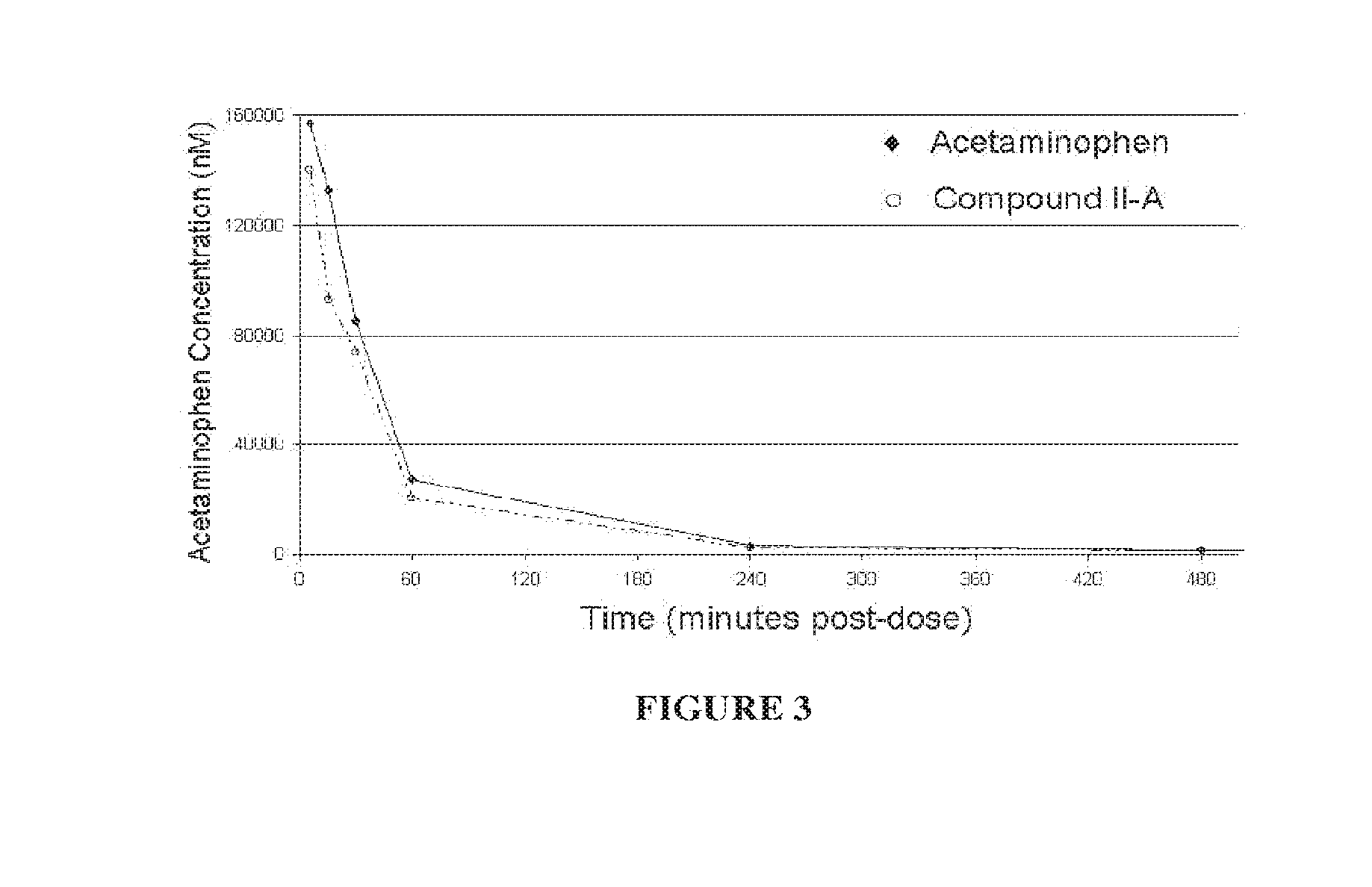Hepatoprotectant acetaminophen mutual prodrugs
a technology of acetaminophen and mutual prodrugs, which is applied in the direction of anti-noxious agents, drug compositions, cardiovascular disorders, etc., can solve the problems of high degree of uncertainty, complicating the safety profile of acetaminophen, and acetaminophen may be toxic to the liver, so as to delay the onset of acetaminophen action, and slow the acetaminophen
- Summary
- Abstract
- Description
- Claims
- Application Information
AI Technical Summary
Benefits of technology
Problems solved by technology
Method used
Image
Examples
example 1
Synthesis of (S)-4-acetamidophenyl2-amino-4-(methylthio)butanoate
[0169]
[0170]A white color milky suspension of L-methionine (3 g, 20 mmol) in THF (30 mL) and 10% NaOH solution (10 mL) was stirred for 30 min before turning into a clear colorless solution. To this Boc anhydride (6.58 g, 30.1 mmol) was added slowly over about 15 min at RT. The clear colorless solution was stirred further 12 h at RT. The reaction was monitored by TLC (DCM:MeOH (95:5 mL); TLC silica gel 60 F254 (Merck), detection with Ninhydrin solution (5% in Methanol); Rf values, product: 0.7, L-methionine: 0). After 12 h the clear colorless solution was turned to light brown color solution. This light brown color solution was evaporated under vacuum; a light brown color gummy material (thick oil) was obtained which was taken into ethyl acetate and water (60 mL: 10 mL); pH of the solution was adjusted to 6 by using 20% citric acid solution (15 mL). The light brown layer of ethyl acetate was separated and dried over sod...
example 2
Synthesis of 2-acetamido-3-((2-acetamido-3-(4-acetamidophenoxy)-3-oxopropyl)disulfanyl)propanoic acid
[0173]
[0174]To a stirring milky suspension of N-Acetyl cysteine (0.2 g; 1.23 mmol) in DCM (5 mL) at 0° C. was added a catalytic amount of acetic acid followed by N-chlorosuccinimide (0.18 g; 1.35 mmol). The milky suspension was stirred at 0° C. for 30 min. In another round bottom flask, a milky suspension of 4-acetamidophenyl 2-acetamido-3-mercaptopropanoate (0.25 g; 1.23 mmol) in DCM (5.0 mL) and TEA (0.28 mL 2.45 mmol) was prepared and cooled to at 0° C. This milky suspension was added to the above N-Acetyl cysteine suspension. The resulting reaction mixture turned from milky suspension to a clear light orange solution within 15 min of 2.5 hours of stirring at 0° C. The reaction mixture was then evaporated under vacuum at 40° C. to yield light orange syrup, which was washed with diethyl ether (2×20 mL) and finally purified by preparative HPLC to generate a white crystalline solid o...
example 3
Synthesis of 3-((3-(4-acetamidophenoxy)-2-amino-3-oxopropyl)disulfanyl)-2-aminopropanoic acid dihydrochloride
[0175]
[0176]To a stirring colorless suspension of disulfide-linked cysteine (3,3′-disulfanediylbis(2-aminopropanoic acid), 5 g; 20.80 mmol) in THE (50 mL) was added 10% NaOH solution (25 mL) and stirred for 15 mints at RT. After 15 minutes, colorless suspension turned to a clear colorless solution, which was cooled to 0° C. and Boc anhydride (13.6 g; 62.42 mmol) was added. The reaction mass was warmed to RT and stirring continued for 12 hours. The reaction was monitored by TLC (methanol:dichloromethane (20:80); TLC silica gel 60 F254 (Merck); detection with λ254 nm UV; Rf values, starting material: 0, boc-protected starting material; 0.2). After the reaction was completed, the reaction mixture was evaporated to dryness. The crude compound was taken into DI water (20 mL) and washed with ethyl acetate (50 mL). The ethyl acetate layer was removed and the aqueous layer was acidif...
PUM
| Property | Measurement | Unit |
|---|---|---|
| temperature | aaaaa | aaaaa |
| concentration | aaaaa | aaaaa |
| concentration | aaaaa | aaaaa |
Abstract
Description
Claims
Application Information
 Login to View More
Login to View More - R&D
- Intellectual Property
- Life Sciences
- Materials
- Tech Scout
- Unparalleled Data Quality
- Higher Quality Content
- 60% Fewer Hallucinations
Browse by: Latest US Patents, China's latest patents, Technical Efficacy Thesaurus, Application Domain, Technology Topic, Popular Technical Reports.
© 2025 PatSnap. All rights reserved.Legal|Privacy policy|Modern Slavery Act Transparency Statement|Sitemap|About US| Contact US: help@patsnap.com



